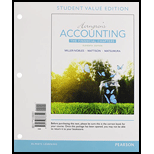
Concept explainers
Concept Introduction:
Perpetual Inventory System: The perpetual inventory system records and updates the inventory after each and every transaction. The inventory balance is updated after each transaction and it is kept up to date at every time.
FIFO method: FIFO Stands for First In First Out. Under this method, the units purchased first are assumed to be sold first and cost of goods sold is calculated accordingly. The ending inventory in the method includes the latest units purchased.
LIFO method: LIFO Stands for Last In First Out. Under this method, the latest units purchased are assumed to be sold first and cost of goods sold is calculated accordingly. The ending inventory in the method includes the oldest units purchased.
Weighted Average method: Under this method, the cost per unit of the inventory is calculated as weighted average cost per unit and the cost of goods sold and inventory is calculated with the help of weighted average cost per unit.
Requirement-1:
To determine: The Ending Merchandise Inventory, Cost of Goods sold and Gross Profit using the FIFO inventory costing method
Requirement-2:
To determine: The Ending Merchandise Inventory, Cost of Goods sold and Gross Profit using the LIFO inventory costing method
Requirement-3:
To determine: The Ending Merchandise Inventory, Cost of Goods sold and Gross Profit using the Weighted Average inventory costing method
Want to see the full answer?
Check out a sample textbook solution
Chapter 6 Solutions
Horngren's Accounting, The Financial Chapters, Student Value Edition Plus MyLab Accounting with Pearson eText -- Access Card Package (11th Edition)
- Please help me solve this general accounting question using the right accounting principles.arrow_forwardPlease explain the solution to this general accounting problem with accurate explanations.arrow_forwardI need help with this financial accounting problem using accurate calculation methods.arrow_forward
- Grouper Corporation purchased machinery on January 1, 2025, at a cost of $264,000. The estimated useful life of the machinery is 4 years, with an estimated salvage value at the end of that period of $31,400. The company is considering different depreciation methods that could be used for financial reporting purposes. (a) Prepare separate depreciation schedules for the machinery using the straight-line method, and the declining-balance method using double the straight-line rate.arrow_forwardYour company reported the following financial data for the year: • Net sales: $1,200,000 • Average total assets: $800,000 • Operating income: $90,000 • Required rate of return: 10% What is the asset turnover for the year? a) 1.25 times b) 1.50 times c) 1.80 times d) 2.00 timesarrow_forwardPlease explain the solution to this general accounting problem with accurate principles.arrow_forward
- Can you provide the valid approach to solving this financial accounting question with suitable standards?arrow_forwardCan you solve this general accounting question with the appropriate accounting analysis techniques?arrow_forwardI need guidance with this general accounting problem using the right accounting principles.arrow_forward

 AccountingAccountingISBN:9781337272094Author:WARREN, Carl S., Reeve, James M., Duchac, Jonathan E.Publisher:Cengage Learning,
AccountingAccountingISBN:9781337272094Author:WARREN, Carl S., Reeve, James M., Duchac, Jonathan E.Publisher:Cengage Learning, Accounting Information SystemsAccountingISBN:9781337619202Author:Hall, James A.Publisher:Cengage Learning,
Accounting Information SystemsAccountingISBN:9781337619202Author:Hall, James A.Publisher:Cengage Learning, Horngren's Cost Accounting: A Managerial Emphasis...AccountingISBN:9780134475585Author:Srikant M. Datar, Madhav V. RajanPublisher:PEARSON
Horngren's Cost Accounting: A Managerial Emphasis...AccountingISBN:9780134475585Author:Srikant M. Datar, Madhav V. RajanPublisher:PEARSON Intermediate AccountingAccountingISBN:9781259722660Author:J. David Spiceland, Mark W. Nelson, Wayne M ThomasPublisher:McGraw-Hill Education
Intermediate AccountingAccountingISBN:9781259722660Author:J. David Spiceland, Mark W. Nelson, Wayne M ThomasPublisher:McGraw-Hill Education Financial and Managerial AccountingAccountingISBN:9781259726705Author:John J Wild, Ken W. Shaw, Barbara Chiappetta Fundamental Accounting PrinciplesPublisher:McGraw-Hill Education
Financial and Managerial AccountingAccountingISBN:9781259726705Author:John J Wild, Ken W. Shaw, Barbara Chiappetta Fundamental Accounting PrinciplesPublisher:McGraw-Hill Education





